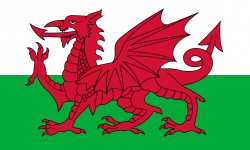Wales Welsh Dragon
A creature that has rough scaly skin, vicious claws, bat-like webbed wings, and gigantic size – this is the image that comes to mind whenever you hear the word dragon. Such was the legendary dragon of Wales that has been imprinted on the national flag and is remembered to this date by the Welsh. The fierce red dragon in a passant position on a white and green background represents the ancient and proud battle standard of the Welsh army.

Wales is an integral part of the United Kingdom but is not represented on the Union Jack, also known as the Union Flag. In 1959, the current flag was adopted by the government of Wales, which has an association with an old royal badge. Since the times of Tudor, this badge has been used by British kings and queens and has undergone several changes over time with the theme of a red dragon featured in all variations.
The Legend of the Welsh Dragon
The Welsh Dragon is associated with the legend of Vortigern – the Celtic King. It tells the tale of the time when the King fled to Wales in order to escape from Anglo-Saxon invaders. During his stay, he decided to build a fortress on the mysterious Dinas Emrys hill. Beneath the castle was a lake where two dragons (one white, one red) lay asleep. As Vortigern’s men dug deeper, they found the dragons that started to fight each other the moment they woke up. The red dragon emerged victoriously and was said to represent the King and his people.

The symbol has been used by British soldiers on the battle banners in the 4th century when they marched to Rome. The Welsh kings of the 5th century adopted the red dragon to establish their continued authority and power following the Romans’ defeat. The white and green colors were introduced by Henry VII, the first Tudor king. During his reign, the symbol became an emblem of the Royal Navy ships.
The popularity of the Welsh dragon faded over time and wasn’t made a part of the Union Jack of 1606. But in 1959, Queen Elizabeth declared that flags with the red dragon and a white and green background should be erected on all Wales’ government buildings.




